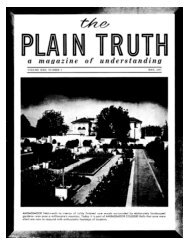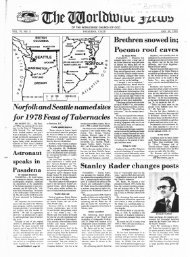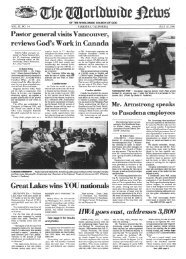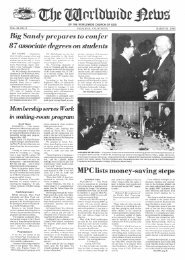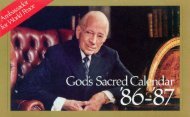The Biblical Basis of the Sacred Calendar Part One
The Biblical Basis of the Sacred Calendar Part One
The Biblical Basis of the Sacred Calendar Part One
You also want an ePaper? Increase the reach of your titles
YUMPU automatically turns print PDFs into web optimized ePapers that Google loves.
days. (In <strong>the</strong> case <strong>of</strong> <strong>the</strong> Sanhedrin, this is because it was uncertain until <strong>the</strong> very last moment when <strong>the</strong><br />
witnesses <strong>of</strong> <strong>the</strong> new crescent would arrive, and <strong>the</strong>refore whe<strong>the</strong>r <strong>the</strong> Sanhedrin would sanctify <strong>the</strong> 30th<br />
or <strong>the</strong> 31st day since <strong>the</strong> previous new crescent as being <strong>the</strong> "new moon".) Nor can we account for this<br />
rule by claiming (as did <strong>the</strong> Talmudists and Maimonides) that "if <strong>the</strong> molad falls before noon, <strong>the</strong> moon<br />
can be seen <strong>the</strong> same day near sunset". This is not true all <strong>the</strong> time, or anything like it!<br />
First, apart from exact knowledge <strong>of</strong> <strong>the</strong> irregularities <strong>of</strong> <strong>the</strong> motions <strong>of</strong> <strong>the</strong> sun and moon (which <strong>the</strong> Jews<br />
did not have and could not have had), one must base a lunisolar calendar ei<strong>the</strong>r on <strong>the</strong> calculation <strong>of</strong><br />
mean values or on direct observation. Under <strong>the</strong>se conditions, if <strong>the</strong> calendar is based on <strong>the</strong> calculation<br />
<strong>of</strong> Molad Tishri, <strong>the</strong>n one may know years (even centuries) in advance when Tishri 1 will occur. If <strong>the</strong><br />
calendar is based on observation <strong>of</strong> <strong>the</strong> new crescent, one cannot know in advance when <strong>the</strong> first day <strong>of</strong><br />
any month will occur -- in which case one cannot "sanctify <strong>the</strong> new moon" until <strong>the</strong> new crescent actually<br />
appears at sunset!<br />
Second, <strong>the</strong> new crescent <strong>of</strong> Tishri cannot be seen from Jerusalem less than 20 hours after <strong>the</strong> true<br />
astronomical conjunction (or less than six hours after <strong>the</strong> mean astronomical conjunction, <strong>the</strong> same in<br />
principle as <strong>the</strong> calculated molad), and <strong>the</strong>n only at sunset. (<strong>The</strong> new crescent may appear at sunset<br />
nearly 72 hours after <strong>the</strong> true conjunction!) Remember, too, <strong>the</strong> true conjunction can precede Molad Tishri<br />
by a maximum <strong>of</strong> 14 hours or follow it by a maximum <strong>of</strong> six to seven hours. Finally, <strong>the</strong> Jews had no way<br />
<strong>of</strong> knowing in advance how far apart Molad Tishri and <strong>the</strong> true conjunction would be, or even which would<br />
occur first!<br />
True, <strong>the</strong> minimum time between Molad Tishri and <strong>the</strong> new crescent is six hours (noon to sunset). But this<br />
is a very rare event. An exceptional event cannot be used to justify a general rule.35 Besides (and this is<br />
most important), a local calendar that begins each month with <strong>the</strong> new crescent does not require a "noonor-after"<br />
postponement <strong>of</strong> any kind. According to <strong>the</strong> Talmud, <strong>the</strong> Pharisee-led Sanhedrin had to "sanctify<br />
<strong>the</strong> new moon" during <strong>the</strong> "day" (Sanhedrin 11b); but that meant in practice between sunset and full dark.<br />
So <strong>the</strong> very existence <strong>of</strong> Rule 2 in our present calendar proves that our received calendar is not <strong>the</strong> same<br />
as that <strong>of</strong> <strong>the</strong> Pharisees and <strong>the</strong>ir Rabbinic heirs. A "noon-or-after" postponement for Tishri 1 only makes<br />
sense in a calendar that begins <strong>the</strong> months with <strong>the</strong> mean conjunction -- and that only as reckoned<br />
according to world time, not Jerusalem time. Were <strong>the</strong> molad reckoned against noon Jerusalem time, <strong>the</strong><br />
calendar would put <strong>the</strong> effective "date line" more than fifty degrees <strong>of</strong> longitude west <strong>of</strong> where it should be<br />
for <strong>the</strong> benefit <strong>of</strong> everyone.<br />
<strong>The</strong> O<strong>the</strong>r Three Postponements<br />
Is <strong>the</strong>re a biblical reason for Postponement Rule 1 (Trumpets cannot fall on <strong>the</strong> first, fourth or sixth days<br />
<strong>of</strong> <strong>the</strong> week)? If so, <strong>the</strong>n since we know that Rule 2 also has a biblical basis (one dating back to Creation<br />
Week), we know that Rules 3 and 4 have a biblical basis in principle as well. <strong>The</strong>se last two rules are but<br />
corollaries <strong>of</strong> <strong>the</strong> first two, and <strong>of</strong> <strong>the</strong> necessary limits on <strong>the</strong> lengths <strong>of</strong> <strong>the</strong> common and leap years in a<br />
19-year cycle (that is, in a calendar based on calculation <strong>of</strong> <strong>the</strong> molad).36<br />
What reason does Rabbinic Judaism give for Rule 1? Mainly, to keep Atonement from falling on <strong>the</strong> sixth<br />
or first day <strong>of</strong> <strong>the</strong> week, and to keep <strong>the</strong> seventh day <strong>of</strong> <strong>the</strong> Feast <strong>of</strong> Tabernacles (called Hoshannah<br />
Rabbah by Rabbinic Judaism) from falling on <strong>the</strong> Sabbath.37 But why are <strong>the</strong>se days singled out (and<br />
one <strong>of</strong> <strong>the</strong>m not even being a Holy Day)? Could this Jewish tradition be yet ano<strong>the</strong>r post hoc explanation<br />
obscuring <strong>the</strong> real reason for this rule?<br />
Some in <strong>the</strong> Church <strong>of</strong> God have sought to justify <strong>the</strong> rule by this means: If Trumpets could fall on<br />
Sunday, Wednesday or Friday, <strong>the</strong>re would be four, two or four consecutive Holy Day/Sabbath<br />
combinations in a given year. Preventing this from happening would have a number <strong>of</strong> benefits, especially<br />
for women (who bear <strong>the</strong> brunt <strong>of</strong> food preparation for <strong>the</strong>ir families, now as in <strong>the</strong> past). Given <strong>the</strong> biblical








